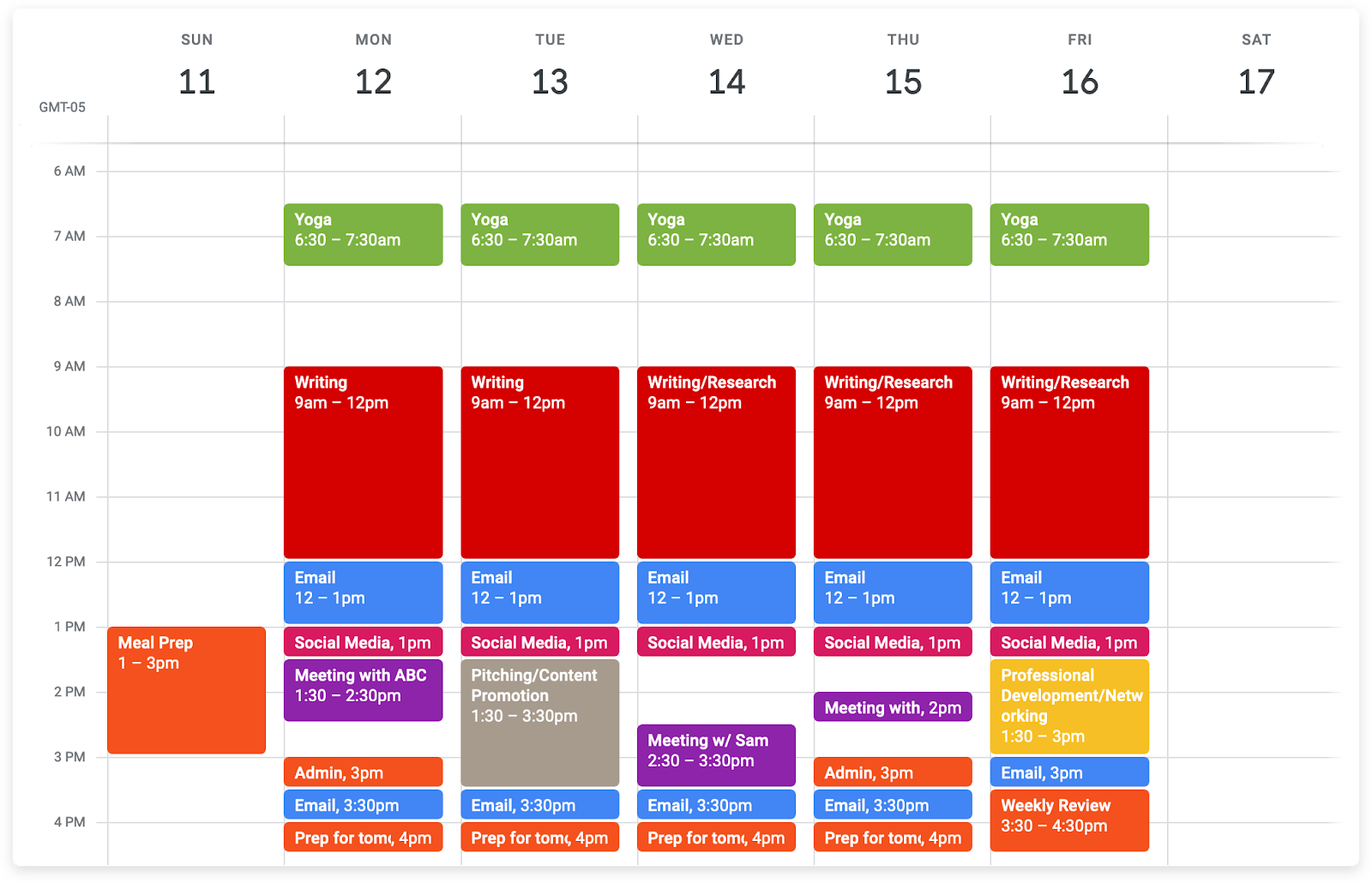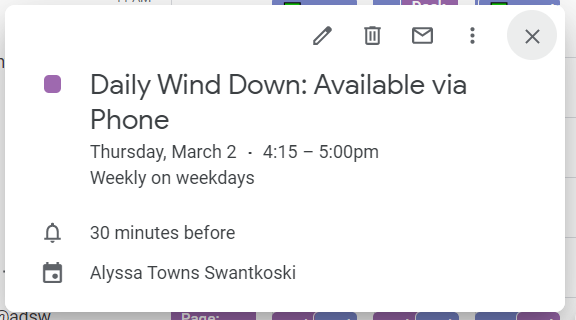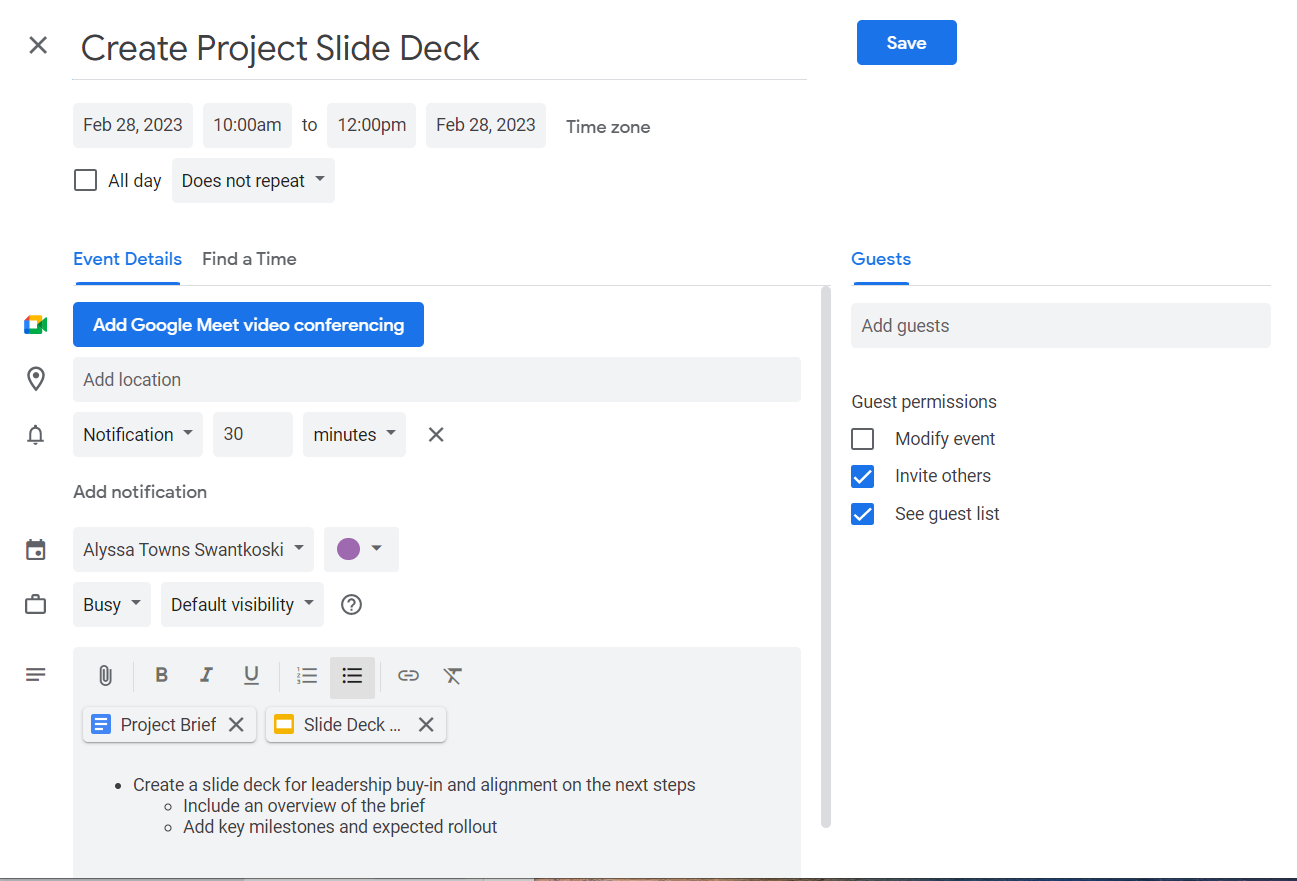Talk to anyone you know, and you will likely hear one of the following at some point when you ask what they have been up to or if they had a chance to get around to a task:
- “I haven’t had the time.”
- “I’ve been busy and didn’t get to all the items on my to-do list.”
- “I’ve wanted to try that, but it doesn’t fit my current schedule.”
- “I always have too much to do and not enough time to do it.”
Do these statements sound familiar?
While there are plenty of instances where we find ourselves juggling too many balls at once and having too much on our plates, there’s often an opportunity to manage how we spend our time better. And it doesn’t have to feel daunting and arduous to do so.
In this post, we’ll teach you how to use time blocking in Google Calendar (bonus points if you let Clockwise help you block your calendar) so the narrative shifts from “I haven’t had the time” to “I blocked some time to do that this week,” and “I always have too much to do and not enough time to do it” to “Time blocking is helping me make the most of my time and prioritize effectively in all areas of my life.”
You’ll learn the following:
- 7 benefits of time blocking and why you should give it a try
- How to get started with time blocking (or how to prepare your to-do list before using Google Calendar)
- The features and functionality you can take advantage of when blocking your time with Google Calendar
- Why Clockwise is a must for helping you block your time
Let’s get started!
Benefits of time blocking
The benefits of time blocking are undeniably great (and we aren’t just saying that because we love time blocking here at Clockwise!) It’s a relatively simple time management technique that boasts many great benefits, including the following:
Control of your to-do list
Time blocking gives you a holistic look at what you need to do and when you will do it. To-do lists can be ineffective and unhelpful without a plan and dedicated time to complete the tasks. When you block your time, you’re setting aside dedicated time to tackle your to-do list and logically organize your tasks to ensure you meet deadlines and get your highest-priority work done.
More deep work
Time blocking enables you to schedule more time for deep work, otherwise known as creative, focused, deeply human work (see Deep work tips to help you make the most of your time) because you can save time on your calendar for it. It’s easy to think you have time in your day for deep work, but before you know it, urgent issues, distractions, unexpected meetings, and a slew of other interruptions can steal that time from you.
Less procrastination
I don’t know about you, but when I see free time on my calendar, I feel a sense of joy and sometimes simultaneously feel lost because I don’t know how to spend it. Should I take a break? Or get to work on my to-do list? Maybe I should catch up on Slack messages? My final decision depends on the day, but I’ll admit when my calendar is open, and I have free rein, it’s not uncommon for procrastination to settle in and my to-do list to fall to the wayside.
Better work-life balance
One of the best parts about time blocking is that it works great for professional tasks and to-dos and is also helpful for personal events and commitments. When you block your time and start to take back your day, you’ll likely find it easier to uphold your boundaries between work and non-working hours and find a better balance.
Focus Time > context switching
As part of time blocking (and more on this later), you can (and should) group similar tasks and schedule a block of time to complete them. Grouping similar work helps reduce and prevent context switching. Additionally, when you block your time for the week, you can schedule Focus Time to avoid unnecessary context switching that will inevitably throw you off your productivity game.
More organization and task batching
My workday needs may differ from yours, so I may need to use a different system to organize my day. For example, let’s say I have five hours of meetings and three hours left for the items on my to-do list. Since I have limited time, I need to prioritize my to-dos by the deadline to ensure I finish my work on time. Maybe you’re at the start of a sprint and don’t have any nearby deadlines, so you want to group your tasks by project. No matter which schedule works best, time blocking allows both of us to meet our workday needs.
Healthy boundaries
Time blocking your calendar with the tasks and activities you have on your plate each day can help you determine when you can and can’t agree to urgent items or last-minute plans. Knowing what you need to accomplish, where you need to be, and your highest priorities are crucial for setting and maintaining the boundaries you deserve.
How to set up Google Calendar for time blocking
Whether you’re excited to try a new time management strategy, want to enjoy and experience any combination of the benefits above, or need a better handle on your Google Calendar—you’re in the right place. Before we jump into the nitty gritty of Google Calendar and how to add your tasks, let’s review the steps you’ll need to take to prepare your to-do list before you block time for your tasks.
A reference guide for getting started with time blocking
At its core, time blocking is simple and relatively straightforward. Here’s what you need to remember when it comes to organizing your to-do list (reader: check out Time blocking 101: Your guide to getting started for more information):
1. Grab (or create) your to-do list.
To start time blocking, you need to know what you need to spend your time on. We recommend deciding what you need to do this week, but you can start with a shorter timeframe if it makes sense.
For the best results, strive to create a comprehensive list, but know that unexpected items will likely arise. Don’t worry about unforeseen or urgent tasks that might come up. Simply do your best to create your to-do list with the knowledge you have right now.
To-do lists are great, but without structure, they’re merely lengthy lists of disorganized items and actions. So once you know what you need to do, you need to prioritize your tasks. The Eisenhower Matrix is one of our favorite methods for prioritizing and categorizing tasks.
2. Estimate completion times for each task.
With your prioritized to-do list in hand, the next step is to consider how long each task will take you to complete. Don’t get hung up on this part. Give it your best guess, and bake in a little bit of buffer time.
If your estimates seem legitimate but won’t really fit into your calendar, try breaking the task down into smaller micro-tasks. For example, if you have a task that you plan to work on Wednesday afternoon that will take you three hours to complete, but you also have three hours of meetings, consider breaking down the task to identify good starting and stopping points.
3. Schedule your tasks on your calendar, and let the magic happen!
Now you can block off chunks of time on your Google Calendar for your tasks. You can do this in many ways, depending on your preferences and schedule.
If your job is meeting-heavy, you may want to try task batching between meetings to maximize your non-meeting hours. Or maybe you’re a morning person and want to reserve a couple of hours of Focus Time first thing for deep work.
Whatever the case may be, time blocking is customizable and can meet a variety of needs. Below is an example of what your time-blocked calendar might look like after you schedule your to-dos:

And here’s another example from our friends at Todoist that includes personal and professional tasks and commitments:

Image source: Todoist
What does the "time blocked" option do on Google Calendar?
You might think, “Those examples look great, organized, and colorful, but how do I get my Google Calendar to look like that?”
Fortunately, Google Calendar provides a handful of different customization options and features that can help you create a calendar that looks like Todoist’s example above. Here are five neat ways to maximize time blocks on Google Calendar.
1. Use clear event names.
Have you ever created a calendar event and added “Busy” for the title? Or made a calendar hold in a rush and forgot to add a title, so it read, “(No title)?” I get it—sometimes it happens. But what if I told you you’re missing out on an opportunity to own your time effectively?
Giving your calendar events and tasks clear names doesn’t only benefit you as you cruise through your to-do list and lets others know what you’re doing and when it’s a good time to reach you (or not). In many instances, other people in your organization can see your Google Calendar details, and the name of the calendar event is the first thing they’ll see when viewing your calendar.
When you label your tasks, consider indicating whether you are available or unavailable. Experiment with using terms and phrases like:
- Available via phone or Slack
- Unavailable
- Do not book, please
- Ask before booking
I have a time block on my calendar to wrap up my day and start to wind down. During that time, I let my colleagues know I’m available by phone only, which is particularly helpful during the summer months when I can get outside in the evenings. Here’s what that looks like:

2. Add descriptions, details, and links for easy access.
One of the best parts about using Google Calendar events to manage your tasks is that you can add context and supporting materials directly to the event to save yourself time later. For example, if you are planning to work on a slide deck for a project, you can include the name of the project in your event name, attach the slide deck template and other project resources to the event, and add notes in the description.
Here’s an example of what this can look like:


When it’s time for me to work on this task, I have everything I need to dive right in and won’t waste time searching for the slide deck template or trying to recall what this task name means.
3. Use the “repeat” feature for recurring tasks.
Save time by creating recurring time blocks for tasks that you do daily, weekly, monthly, or on some other cadence (your future self will thank you). Google Calendar allows you to create one-time and recurring events so you can avoid manually making each time block individually.
For example, you could block 30 minutes every morning to respond to emails and Slack messages before diving into your to-dos.
To adjust the schedule for a task, simply click the dropdown next to “Does not repeat” under the event title and choose a schedule or create a custom one of your own.

4. Manage your privacy and schedule visibility.
Transparency is key for building high-performing teams, but sometimes you might be working on a confidential task or need to block time on your calendar for a personal and private matter. With Google Calendar, you have the option to mark events as “Private” so that others can only see that you are busy during a specific task but can’t view any details about your event.
As a former executive assistant, I know how challenging it can be to manage your to-do list digitally without releasing confidential and private information. I love this functionality because it allows you to block your time even if you can’t or don’t want to share with others what you are using that time for.

5. Use color coding to distinguish between types of tasks.
If you love to visualize your schedule and the work ahead of you, you will love the color coding option in Google Calendar. You can choose different colors for each time block or category of tasks to tell them apart. It can be helpful to designate colors for professional and personal tasks. And you can go a layer deeper by color coding your workday.
Below is an example of a color legend and how it might look on a calendar:
- Focus Time = red
- Meetings = orange
- Administrative tasks = green
- Group collaboration = purple
- Personal events = blue
- Exercise = yellow

Clockwise can automate time blocking for you
While Google Calendar has much to offer from a time-blocking perspective, it requires additional time to add your time blocks and plan out your schedule manually. But there’s an easier way!
Clockwise can help make your day work for you by helping you block your time without you having to give it much thought. With Clockwise, you can:
- Determine how much Focus Time you need and let Clockwise schedule it for you
- Mark meetings flexible so they move to the best times for you and your team
- Enable meeting break holds so you can enjoy a break between consecutive meetings
- Reschedule meeting conflicts automatically
- Create a daily lunch hold
- Sync your personal calendar to avoid conflicts
- Have travel time blocks added to your calendar when traveling to and from meetings and events
And so much more! Here’s a quick look at how Clockwise can help you optimize and organize your calendar automatically.
Going forward
Time blocking your Google Calendar will help you take control of your to-do list, avoid context switching, enjoy a healthy work-life balance, and so much more. When you use Google Calendar to block your time, be sure to take advantage of event descriptions, recurring scheduling options, and color-coding functionality. To make your days work better for you without a lot of effort, download Clockwise and give it a try.


.gif)



